exploring relay circuits and meishuo: an innovative approach to circuit design
Release time:2025-04-30 14:33:31
A relay circuit is a fundamental component in electrical engineering, enabling control over high-power devices through low-power signals. The basic operation of a relay involves an electromagnetic coil that, when energized, creates a magnetic field to move a switch. This allows for the control of various devices, such as motors, lights, or other electrical components. Relays are widely used in various industries and everyday applications, such as home automation, industrial machinery, and vehicle systems. In recent years, the company Meishuo has brought a fresh perspective to the design and use of relay circuits, particularly in smart and energy-efficient systems.

What is a Relay Circuit?
A relay is essentially an electrically operated switch. Its main function is to isolate one circuit from another while allowing control of high voltage or high current devices with a low-voltage signal. It consists of an electromagnet, a set of contacts, and a spring-loaded armature. When current flows through the coil, the magnetic field pulls the armature, changing the state of the contacts (from open to closed or vice versa). The contacts then complete or break the circuit in the high-power side, controlling the devices connected to it.
Relay circuits are commonly used to control devices that require a higher current than the controlling device can supply. For instance, a microcontroller or a low-voltage switch can control a relay that, in turn, operates a 220V household appliance. They are highly valued for their ability to control circuits without direct electrical connection between the controlling and controlled circuits.

